Tempura: How to Eat, Types, Best Restaurants, and More

Tempura is a type of deep-fried cuisine popular in Japan. We introduce the standard tempura dishes, how to eat them, and restaurants where you can try tempura in Tokyo, Kyoto, and Osaka.
Tempura: A Must-Try Japanese Dish
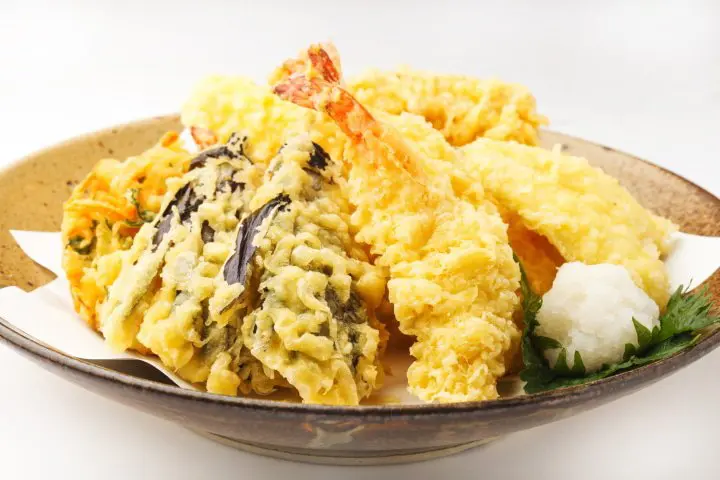
Photo by Pixta
Tempura is the name for dishes that have been dipped in a mixture of cold water, flour, and egg, then fried in oil. Because there are eggs in the mixture, some might assume that tempura are like fritters, where the egg whites are whipped, but this is not the case.
The ingredients vary by season, but in general edible plants, vegetables, shrimp, squid, Japanese whiting, and other types of seafood are used in tempura.
Tempura in Japan: Types, How to Eat, and Restaurants
1. Shrimp Tempura
2. White Fish Tempura
3. Squid Tempura
4. Sweet Potato Tempura
5. Pumpkin Tempura
6. Eggplant Tempura
7. Shishito Pepper Tempura
8. Mushroom Tempura
9. Vegetable Tempura Mix (Kakiage)
10. Tempura Assortment
About Tempura Flavoring
Popular Tempura Menus
- Ten-don
- Tempura with Noodles: Tempura Soba or Tempura Udon
- Tempura Teishoku (Set Meal)
- Tempura Sandwich
- Ten-musu or Tempura Makizushi
Table Manners when Eating Tempura
Tempura Restaurants in Tokyo
Tempura Restaurants in Kyoto
Tempura Restaurants in Osaka
History of Tempura Cuisine in Japan
Though tempura is considered a model of Japanese cooking, the root of the word "tempura" is theorized to have come from the Portuguese "tempero" (cooking) or Spanish "templo" (temple) which spread to Japan via foreign missionaries.
Tempura came through Japan during the Edo era, where "fast, cheap, delicious" fast foods for the masses became popular.
Tempura originated as a fried food that was introduced through Portugal back in the 16th century. It was originally called "temparada" and is said to have derived from a Christian custom of eating fried vegetables when they avoid eating meat, especially during Lent. It was introduced to Japan and slowly evolved into the "tempura" we are familiar with in the modern day.
There are different types of tempura, each offering unique flavors and textures, which we introduce below.
Shrimp Tempura (Ebi Tempura)

Photo by Pixta
Crispy-coated shrimp, deep-fried until golden. One of the most popular types of tempura. It is made using a combination of tempura batter and firm shrimp.
White Fish Tempura

Photo by Pixta
White fish coated in batter and deep fried. The most common type of fish used for white fish tempura is whiting. Depending on the season and region, conger eel is used for this tempura.
Squid Tempura
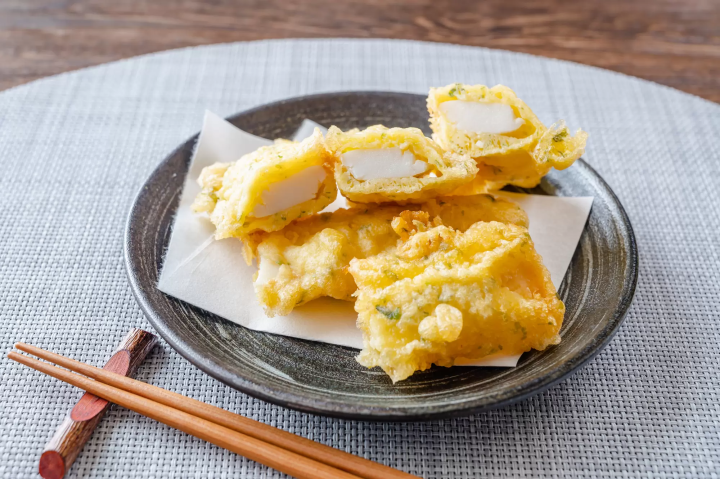
Photo by Pixta
Squid rings or squid pieces coated in batter and deep fried, offering a tender yet crispy texture. High-end tempura restaurants use bigfin reef squid, which has a strong sweet and savory flavor.
Sweet Potato Tempura
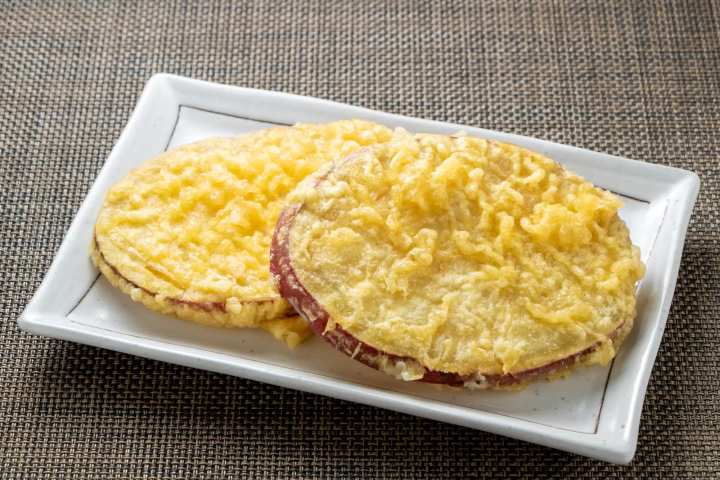
Photo by Pixta
Thinly sliced sweet potatoes are coated in batter and deep fried, providing a sweet and crispy experience. It has a particular sweetness that only sweet potatoes have, and its fluffy texture makes this a popular tempura dish among Japanese people.
Pumpkin Tempura
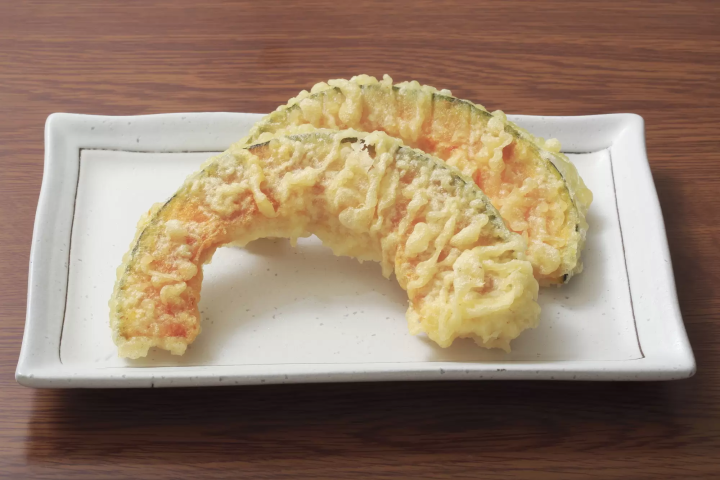
Photo by Pixta
Pumpkin slices battered and deep fried, showcasing a sweet and soft interior with a crispy exterior. Similar to sweet potatoes, pumpkins are characterized by their natural sweetness, and the fluffy taste is popular among Japanese people.
Eggplant Tempura

Photo by Pixta
Eggplant slices or eggplant pieces coated in batter and deep fried, resulting in a soft, juicy texture inside with a crispy and crunchy outside. Although eggplants contain a lot of water and can be difficult to fry crisply, it is a very popular vegetable tempura in Japan.
Shishito Pepper Tempura

Photo by Pixta
Shishito peppers deep fried in a light batter. Sometimes they come with a slight hint of spiciness. Typically this tempura not spicy at all and you can enjoy its delicious aroma.
Mushroom Tempura

Photo by Pixta
Various mushrooms (like shiitake or enoki) coated and deep fried, offering a savory, juicy bite. Shiitake mushrooms are commonly used, but in recent years many types of mushrooms like maitake, enoki, and yamabushitake have also become popular ingredients for tempura.
Vegetable Tempura Mix (Kakiage)
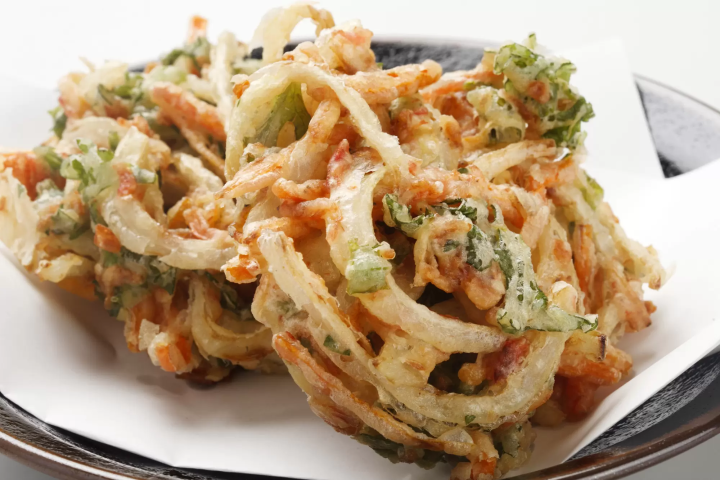
Photo by Pixta
A mix of thinly sliced or chopped vegetables like onions, carrots, and squash, combined in a batter and deep fried together.
Tempura Assortment
Usually found served by restaurants, assortments are a selection of different tempura items served together, allowing you to enjoy a variety of flavors and textures.
Tempura Flavoring is Up to You

Photo by Pixta
Tempura is most commonly eaten with 'ten-tsuyu' - a dipping sauce made from dashi soup stock, soy sauce, and mirin (sweet rice wine).
It's also quite common to add grated ginger or grated Japanese daikon radish to ten-tsuyu; both grated ginger and daikon radish add a refreshing edge to deep fried foods.

Photo by Pixta
Other than ten-tsuyu, in order to really taste the basic ingredients of the dish, tempura may be eaten with just a sprinkling of salt. Recently flavored salts have become popular, such as matcha salt (salt with green tea powder mixed in), curry salt (salt with curry spices), even novel flavors such as yuzu citrus peel or powdered Japanese pepper salts.
And, in small amounts, citrus juices squeezed from lemons or sudachi (similar to a lime) are also great with tempura. There are some people who eat tempura with just soy sauce, Worchester sauce... The flavoring choice is entirely up to you. Half the fun of eating tempura is trying different patterns and matching the ingredients to the best flavors.
Popular Tempura Menus
While you can eat tempura by itself, there are many other dishes which include tempura in them.
Ten-don

Photo by Pixta
Ten-don is a bowl of rice with tempura on top that has had a sauce of concentrated soy sauce, dashi and mirin poured over it; this is a popular type of donburi (*1) dish. Donburi with the tempura mixed into half-scrambled eggs are also popular.
Tempura with Noodles: Tempura Soba or Tempura Udon
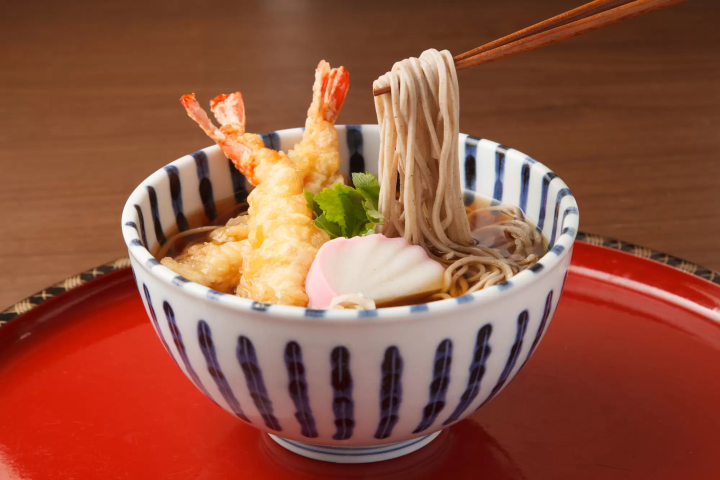
Photo by Pixta
"Ten soba", "ten udon" are dishes where tempura rests on top of thin buckwheat noodles (soba) or on thick flour noodles (udon).
Tempura Teishoku (Set Meal)
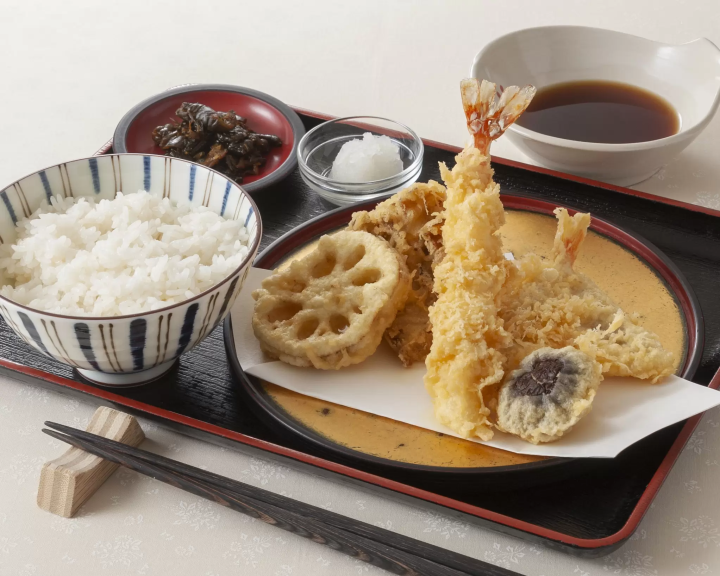
Photo by Pixta
A set meal of tempura often consisting of rice, miso soup, pickles, etc. It is well-balanced in nutrition and is a common household meal.
Tempura Sandwich
This sandwich uses shrimp tempura as a filling. The crunchy tempura and soft bread make a perfect match. It is not really a staple among Japanese people, so you won't find it often on menus at restaurants. But if you do find it, you may be lucky. Give it a try!
Ten-musu or Tempura Makizushi
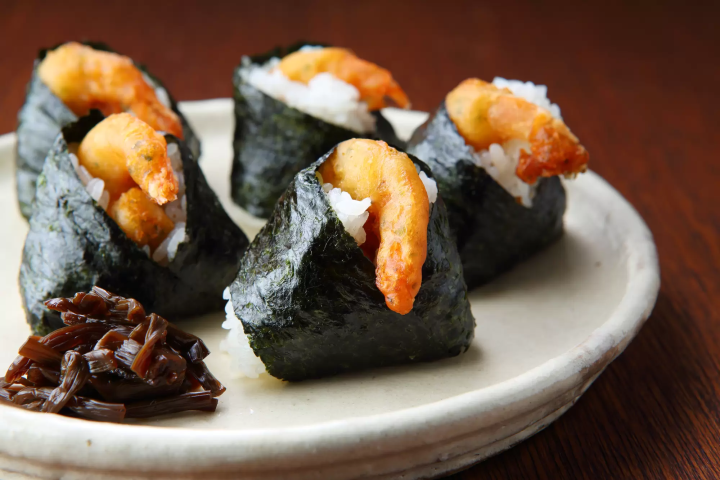
Photo by Pixta
"Ten musu" are shrimp tempura that have been wrapped in onigiri (*2), allowing you to enjoy rice and tempura at the same time.
Tempura Makizushi is a dish that uses tempura as an ingredient in sushi rolls, such as shrimp tempura rolls or vegetable tempura rolls.
Paired with the staples of rice or noodles as a side dish or on its own, tempura is a simple but somewhat fancy dish that is commonly enjoyed for lunch by the Japanese.
*1 Donburi: one dish Japanese meal featuring rice underneath a variety of toppings; the 'don' or porcelain bowl is typically bigger than the usual rice-only bowl.
*2 Onigiri: cooked white rice with a filling, shaped into a tube or a triangle which may or may not be wrapped with roasted seaweed on the outside.
Table Manners when Eating Tempura

When eating tempura at a restaurant, one of the most important things to keep in mind is the order of eating each piece.
When several pieces of tempura are included on one plate, it is standard for the lighter-types (vegetables, shrimp, Japanese whiting) to be placed in front of the heavier-types (such as anago eel). It is recommended to eat the tempura from the front toward the back, as it's believed that the flavors will grow deeper in this manner.
If you would like to try something a bit more luxurious, you might like to visit a tempura shop with a counter where the chef prepares the dishes one by one, right before your eyes; you can eat the dishes while they are piping hot too. At this sort of shop however, it is also very important to keep an eye on when you order and eat each piece.
Tempura is at its most delicious when it is freshly made. No matter how fresh the ingredients are, once tempura has become cold, the crispiness of the batter is lost, so please make sure to enjoy it while it's hot.
Restaurants Where You Can Enjoy Tempura
Nowadays, you can enjoy tempura anywhere in Japan. Tempura is served in a variety of styles, from traditional styles to more modern, creative cuisine. Here, we will introduce three restaurants in each price range in Tokyo, Osaka, and Kyoto.
Tempura Restaurants in Tokyo
Tempura Hachimaki
Tempura Hachimaki is a long-established tempura restaurant that is said to have been frequented by world famous mystery writer, Edogawa Ranpo. Here they serve delicious tempura made with fresh seafood brought in from Tsukiji every morning and the freshest seasonal vegetables.
There is always a line of people waiting, but you usually can get in after waiting for about 5-10 minutes. The prices are affordable, so it's a good place to casually try out. They also have an assortment of menu items like "ten-don" (tempura bowl) and "teishoku" (set meals), which are great for a quick meal. Prices start from 2,000 yen.
Tempura Hachimaki
Address: Tokyo, Chiyoda-ku, Kanda, Jinbocho 1-19
Access: 3 minute walk from Jinbocho Station on the Hanzomon Subway Line or Toei Shinjuku Line
Website: https://gfyg100.gorp.jp/ (Japanese)
Tempura Bar Chopsticks
Chopsticks serves tempura made with a focus on using special healthy ingredients for their batter and salt. Enjoy seasonal flavors carefully selected by the head chef, to their standard dishes they have available.
Their dishes pair well with their shochu and sake which are carefully selected by the owner. Enjoy a relaxing time with their American-influenced interiors with a delicious drink in hand. Prices start from 5,000 yen.
Tempura Bar Chopsticks
Address: Tokyo, Minato-ku, Roppongi 7-16-5 Roppongi Toda Building B1F
Access: 5 minute walk from Roppongi Station on the Hibiya Line
Website: https://tempura-chopsticks.com/ (Japanese)
Mikawa Zezankyo
Mikawa Zezankyo is a long-established tempura restaurant founded in 1920, offering high-quality tempura made with fresh ingredients. Their seating is mostly at the counter, allowing you to see the chef's techniques up close.
The restaurant architecture is the work of 20 artists, and their attention to detail extends to the floors, ceilings, and curtains. The restaurant owner, known as the "God of Tempura," stands at the frying area. Enjoy authentic tempura with a budget of 20,000 to 30,000 yen per person.
Mikawa Zezankyo
Address: Tokyo, Koto-ku, Fukuzumi, 1-3-1
Access: 8-minute walk from Monzen-Nakacho Station on the Tozai Line or Oedo Line.
Website: https://mikawa-zezankyo.jimdofree.com/english-information/
Tempura Restaurants in Kyoto
Komefuku Shijo Karasuma
Komefuku Shijo Karasuma makes healthy tempura made with 100% rice oil producing a crispy texture. The "Komefuku Ten-don" is a tempura bowl that includes shrimp, chicken, soft-boiled egg, vegetables, and much more. Another feature of their restaurant is their deep-fried sashimi. Enjoy the wonderful combination of the rare texture of the sashimi combined with the crispy texture of tempura. Budgets begin from 1,000 yen for lunch and 3,000 yen for dinner.
Komefuku Shijo Karasuma
Address: Kyoto-fu, Kyoto0shi, Nakagyo-ku, Higashinotoin-dori Nishiki-koji-sagaru, Bandoya-cho 658 Miyako Securities Building 1F
Access: 2-minute walk from Karasuma Station on the Hankyu Kyoto Line or a 2-minute walk from Shijo Station on the Karasuma Subway Line
Website: https://komefuku-karasuma.owst.jp/en/
Casual Tempura Endo - Kyoto Kawaramachi Garden
Endo delivers customers a new style of tempura that goes beyond the conventional concepts of tempura. Endo's aim is to offer a new style of high-quality tempura, which often is considered as a luxury, at more affordable prices akin to that of fast food. Prices start from 1,000 yen for lunch and 3,000 yen for dinner.
Casual Tempura Endo
Address: Kyoto, Shimogyo-ku, 68 Shijo Kawaramachi Higashiiru Shinmachi, Kyoto Kawaramachi Garden, 8F
Access: Directly connected to Hankyu Kawaramachi Station
Website: https://kawaramachi.kadoq.com/
Tempura Kyoboshi
Kyoboshi is a small restaurant with only 10 seats at the counter. They are a tempura specialty restaurant, having been in business for three generations and were known only to those in the know.
However, after being featured by Michelin, it has become a restaurant that is widely admired by people in Japan and people overseas. Their menu only consists of a 12,000 yen course with 17 to 18 dishes.
The batter they use does not contain eggs, so the fried food becomes very light. There is no tempura sauce they use. Rather, the tempura is eaten with their sweet and savory salt or with citrus juice.
Kyoboshi
Address: Kyoto-fu, Kyoto-shi, Higashiyama-ku, Hanamikoji, Sueyoshicho, Higashiiru 1-1-10 Futaba Building 1F
Access: 4 minutes walk from Gion-Shijo Station
Website:https://kbun000.gorp.jp/ (Japanese)
Tempura Restaurants in Osaka
Tempura Makino
Although Tempura Makino's prices are reasonable, they do not prepare any food in advance, only serving all freshly fried tempura.
There are counter seats in front of the open kitchen, so you can sit and watch the frying process happen before your eyes. The budget starts from 1000 yen, but we recommend adding options and preparing around 2000 yen.
Tempura Makino
Address: Osaka, Osaka-shi, Kita-ku, Shibata 1-1-3 Hankyu Sanban-gai Minamikan 2F
Access: Directly connected from Osaka Umeda Station
Website: https://www.toridoll.com/shop/makino/ (Japanese)
Toranosumika
Toranosumika is a restaurant specializing in tempura teishoku (set meals). In addition to their set meals, you can also order a la carte dishes or order alcohol or soft drinks. In addition to the standard tempura ingredients they use, they also offer some unique varieties of tempura like chicken and egg. Their tempura can be enjoyed with either their tempura dip or the English rock salt or black truffle salt they have available. The budget is around 2,000 to 4,000 yen.
Toranosumika
Address: Osaka-fu, Osaka -shi, Naniwa-ku, Namba-naka 2-6-1, Kotobuki Building 1F
Access: 10 minutes walk from Namba Station on the Midosuji Line
Ippoh Honten
Founded over 100 years ago, Ippoh is a long-established tempura restaurant, representative of Osaka. Upon entering the Japanese style rooms, you will be served appetizers, seasonal hassun (second course dishes), and seasonal sashimi.
For the second half of the meal, you will move to a private room with counter seats to be served their traditional tempura. Budget is 30,000 yen per person, available for dinner only. This will be an experience you won't forget.
Ippoh Honten
Address: Osaka-fu, Osaka-shi, Nishi-ku, Edobori 1-18-35, Higobashi IP Building 1F/2F
Access: Higobashi Station on the Osaka Municipal Subway Yotsubashi Line
Website: https://www.ippoh.com/honten/ (Japanese)
Enjoy Tempura in Japan
Tempura is a delicious dish and a popular choice among visitors to Japan who are not ready to try the raw ingredients of sushi right away.
Cooked by a skilled chef, tempura can be an exquisite dish. Japanese customers appreciate it best when the outer crust is crispy and the inside is soft, so it's a multifaceted culinary experience.
We hope you take the chance to enjoy tempura in Japan.
Read also
Main image by Pixta
This is the official account of MATCHA's editorial department. Our articles feature useful travel information for visitors to Japan, from how-to guides to recommended places to visit.





































![[Coupon Available] Attention Overseas Winter Sports Fans! Nagano's Sports Depot Has Evolved](https://resources.matcha-jp.com/resize/720x2000/2026/01/05-254819.webp)
![[2 hours from Tokyo ] 10 Quiet and Breathtaking Views of Mount Fuji in Yamanashi Hokuto City , Yamanashi - Part 2](https://resources.matcha-jp.com/resize/720x2000/2025/12/16-253037.webp)

![[Reopening in March 2026] Ikoma Sanjo Amusement Park Park, 45 minutes from Osaka , with free admission](https://resources.matcha-jp.com/resize/720x2000/2024/08/28-194409.webp)